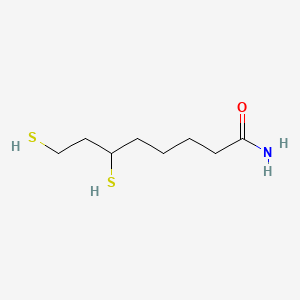| MeSH term | MeSH ID | Detail |
|---|---|---|
| Parkinsonian Disorders | D020734 | 20 associated lipids |
Dihydrolipoamide
Dihydrolipoamide is a lipid of Fatty Acyls (FA) class. Dihydrolipoamide is associated with abnormalities such as Wiskott-Aldrich Syndrome. The involved functions are known as Citric Acid Cycle, Electron Transport, NADH oxidation, Oxidation and Oxidants. Dihydrolipoamide often locates in Mitochondria, Mitochondrial matrix and Chloroplasts. The associated genes with Dihydrolipoamide are Mutant Proteins, Recombinant Proteins, mycothione reductase, Genes, Mitochondrial and alanylproline.
Cross Reference
Introduction
To understand associated biological information of Dihydrolipoamide, we collected biological information of abnormalities, associated pathways, cellular/molecular locations, biological functions, related genes/proteins, lipids and common seen animal/experimental models with organized paragraphs from literatures.
What diseases are associated with Dihydrolipoamide?
Dihydrolipoamide is suspected in and other diseases in descending order of the highest number of associated sentences.
Related references are mostly published in these journals:
| Disease | Cross reference | Weighted score | Related literature |
|---|
Possible diseases from mapped MeSH terms on references
We collected disease MeSH terms mapped to the references associated with Dihydrolipoamide
PubChem Associated disorders and diseases
What pathways are associated with Dihydrolipoamide
There are no associated biomedical information in the current reference collection.
PubChem Biomolecular Interactions and Pathways
Link to PubChem Biomolecular Interactions and PathwaysWhat cellular locations are associated with Dihydrolipoamide?
Visualization in cellular structure
Associated locations are in red color. Not associated locations are in black.
Related references are published most in these journals:
| Location | Cross reference | Weighted score | Related literatures |
|---|
What functions are associated with Dihydrolipoamide?
Related references are published most in these journals:
| Function | Cross reference | Weighted score | Related literatures |
|---|
What lipids are associated with Dihydrolipoamide?
There are no associated biomedical information in the current reference collection.
What genes are associated with Dihydrolipoamide?
Related references are published most in these journals:
| Gene | Cross reference | Weighted score | Related literatures |
|---|
What common seen animal models are associated with Dihydrolipoamide?
There are no associated biomedical information in the current reference collection.
NCBI Entrez Crosslinks
All references with Dihydrolipoamide
Download all related citations| Authors | Title | Published | Journal | PubMed Link |
|---|---|---|---|---|
| McMillan PJ et al. | The human malaria parasite Plasmodium falciparum possesses two distinct dihydrolipoamide dehydrogenases. | 2005 | Mol. Microbiol. | pmid:15612914 |
| Odièvre MH et al. | A novel mutation in the dihydrolipoamide dehydrogenase E3 subunit gene (DLD) resulting in an atypical form of alpha-ketoglutarate dehydrogenase deficiency. | 2005 | Hum. Mutat. | pmid:15712224 |
| Brautigam CA et al. | Crystal structure of human dihydrolipoamide dehydrogenase: NAD+/NADH binding and the structural basis of disease-causing mutations. | 2005 | J. Mol. Biol. | pmid:15946682 |
| Salcedo E et al. | A glycine-cleavage complex as part of the folate one-carbon metabolism of Plasmodium falciparum. | 2005 | Trends Parasitol. | pmid:16039160 |
| Da Sylva TR et al. | Somatic mutations in the mitochondria of rheumatoid arthritis synoviocytes. | 2005 | Arthritis Res. Ther. | pmid:15987486 |
| Vernon SD and Reeves WC | Evaluation of autoantibodies to common and neuronal cell antigens in Chronic Fatigue Syndrome. | 2005 | J Autoimmune Dis | pmid:15916704 |
| Mitra K et al. | Novelty of the pyruvate metabolic enzyme dihydrolipoamide dehydrogenase in spermatozoa: correlation of its localization, tyrosine phosphorylation, and activity during sperm capacitation. | 2005 | J. Biol. Chem. | pmid:15888450 |
| Sauer SW et al. | Bioenergetics in glutaryl-coenzyme A dehydrogenase deficiency: a role for glutaryl-coenzyme A. | 2005 | J. Biol. Chem. | pmid:15840571 |
| Li XJ et al. | Crucial role of two potential cytosolic regions of Nox2, 191TSSTKTIRRS200 and 484DESQANHFAVHHDEEKD500, on NADPH oxidase activation. | 2005 | J. Biol. Chem. | pmid:15684431 |
| Wang W et al. | Proteome analysis of a recombinant Bacillus megaterium strain during heterologous production of a glucosyltransferase. | 2005 | Proteome Sci | pmid:15927046 |
| Tian J et al. | Mycobacterium tuberculosis appears to lack alpha-ketoglutarate dehydrogenase and encodes pyruvate dehydrogenase in widely separated genes. | 2005 | Mol. Microbiol. | pmid:16045627 |
| Klyachko NL et al. | pH-dependent substrate preference of pig heart lipoamide dehydrogenase varies with oligomeric state: response to mitochondrial matrix acidification. | 2005 | J. Biol. Chem. | pmid:15710613 |
| Deres P et al. | Prevention of doxorubicin-induced acute cardiotoxicity by an experimental antioxidant compound. | 2005 | J. Cardiovasc. Pharmacol. | pmid:15613977 |
| Hussain SN et al. | Modifications of proteins by 4-hydroxy-2-nonenal in the ventilatory muscles of rats. | 2006 | Am. J. Physiol. Lung Cell Mol. Physiol. | pmid:16603597 |
| Brown RM et al. | Pyruvate dehydrogenase E3 binding protein (protein X) deficiency. | 2006 | Dev Med Child Neurol | pmid:16904023 |
| Bunik VI et al. | Brain pyruvate and 2-oxoglutarate dehydrogenase complexes are mitochondrial targets of the CoA ester of the Refsum disease marker phytanic acid. | 2006 | FEBS Lett. | pmid:16737698 |
| Lee H et al. | An integrated approach to the prediction of domain-domain interactions. | 2006 | BMC Bioinformatics | pmid:16725050 |
| Smolle M et al. | A new level of architectural complexity in the human pyruvate dehydrogenase complex. | 2006 | J. Biol. Chem. | pmid:16679318 |
| Boucher IW et al. | Structural and biochemical characterization of a mitochondrial peroxiredoxin from Plasmodium falciparum. | 2006 | Mol. Microbiol. | pmid:16879648 |
| Li M et al. | Effect of lpdA gene knockout on the metabolism in Escherichia coli based on enzyme activities, intracellular metabolite concentrations and metabolic flux analysis by 13C-labeling experiments. | 2006 | J. Biotechnol. | pmid:16310273 |
